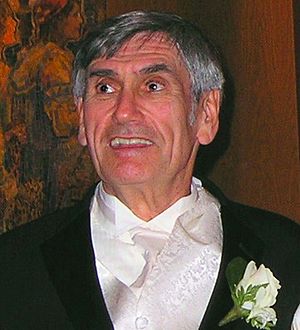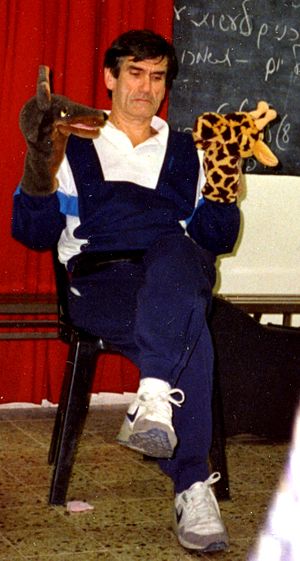Marshall Rosenberg facts for kids
Quick facts for kids
Marshall B. Rosenberg
|
|
|---|---|

Marshall Rosenberg in 2005
|
|
| Born | October 6, 1934 Canton, Ohio, U.S.
|
| Died | February 7, 2015 (aged 80) Albuquerque, New Mexico, U.S.
|
| Nationality | American |
| Alma mater | University of Michigan University of Wisconsin–Madison |
| Occupation | Peacemaker Author |
| Known for | Nonviolent communication |
Marshall Bertram Rosenberg (born October 6, 1934 – died February 7, 2015) was an American psychologist, a person who helps solve problems, an author, and a teacher. He created a special way of talking called Nonviolent Communication (NVC). This method helps people understand each other better and solve problems peacefully.
Marshall Rosenberg worked all over the world to help people find peace. In 1984, he started the Center for Nonviolent Communication. This is a group that teaches NVC to people everywhere.
Contents
Who Was Marshall Rosenberg?
Marshall Rosenberg was born in Canton, Ohio. His parents were Jean and Fred Donald Rosenberg. His family moved to Detroit, Michigan, just before a big riot in 1943. This event showed him how much people can suffer.
He learned early on that he didn't like seeing people hurt others. This feeling helped him want to find ways for people to get along. His family was very loving, which helped him deal with tough times.
Marshall had a younger brother. He often stood up for his brother, even if it meant getting into fights himself. He also loved nature and found peace in places with many trees and few people.
Marshall Rosenberg was married three times. He had three children with his first wife, Vivian. He stayed with his third wife, Valentina, until he passed away in 2015.
How Did He Learn About Psychology?
Marshall Rosenberg was a very smart student. He graduated at the top of his class from Cooley High School in 1952. A friend first told him about psychology, which is the study of the mind and how people behave.
He became very interested in how people think and act. He even wrote a paper in high school about how criminals think. He also got to see what psychology was like in a prison.
Marshall went to college at the University of Michigan. He worked hard to pay for his studies. Later, the state of Wisconsin helped pay for him to become a psychologist.
He learned that psychology should help people who are struggling, not just label them as "sick." He was influenced by books that said people should be seen as having bad luck, not just mental illness. He also learned about how people can learn new ways to act.
During his training, Marshall worked in different places, including schools for troubled kids and hospitals. He started to practice family therapy, where he would talk to all family members, even children, to help them solve problems together.
Developing Nonviolent Communication
Marshall Rosenberg earned his Ph.D. in psychology in 1961. His studies focused on how social situations affect how people see themselves. This idea was important for his later work with Nonviolent Communication.
He started his own psychology practice in St. Louis, Missouri. He noticed that many children had trouble learning in school. He wrote a book about his findings in 1968.
Marshall also started working with groups of people who were fighting for their rights. He taught them how to solve conflicts peacefully. For example, he worked with a group fighting against racism and another group working against sexism. He wanted to help people who were on the "firing line" fighting for human rights.
He realized that his methods could help many people, not just rich clients. He started to train large groups of people in these skills.
Marshall worked for four years to help schools in Norfolk, Virginia, become integrated (where students of all races could attend together). He taught people how to talk about their feelings and needs clearly. He explained it like this: "Figure out what someone did, how you feel about it, why you feel that way, and what you want. Then tell the other person. You'll see amazing things happen!"
He also learned that it was important to celebrate and appreciate each other, not just solve problems. He realized that showing kindness and compassion was a big part of his program.
A Peacemaker Around the World
Marshall Rosenberg traveled to many different countries to share his knowledge of Nonviolent Communication. He helped people in many conflicts. In 2004, he was visiting about 35 countries each year!
He loved seeing how much people could achieve after learning NVC. He said that people wanted to share this process and make things better. They had a lot of energy to spread this kind of work.
Marshall Rosenberg lived in Albuquerque, New Mexico. From there, he supported his followers and the Center for Nonviolent Communication. He passed away at home in 2015. The Center continues his work today, connecting people all over the world with NVC trainers.
See also
 In Spanish: Marshall Rosenberg para niños
In Spanish: Marshall Rosenberg para niños
- List of peace activists
Awards and Recognition
Marshall Rosenberg received many awards for his work as a peacemaker:
- 2014: Hero and Champion of Forgiveness Award from the Worldwide Forgiveness Alliance
- 2006: Bridge of Peace Nonviolence Award from the Global Village Foundation
- 2005: Light of God Expressing in Society Award from the Association of Unity Churches
- 2004: Religious Science International Golden Works Award
- 2004: International Peace Prayer Day Man of Peace Award by the Healthy, Happy Holy (3HO) Organization
- 2002: Princess Anne of England and Chief of Police Restorative Justice Appreciation Award
- 2000: International Listening Association Listener of the Year Award


